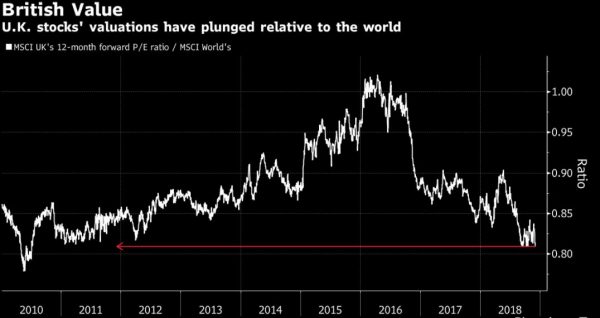It has been another volatile month for the global stock market as the S&P 500, Nasdaq and Dow have all suffered a bumpy ride. In November, the S&P500 gained nearly 1.79%, the Dow 1.6% and the Nasdaq 0.3%. The 30-day implied volatility for the NASDAQ index has touched a level that has not been seen since 2011.
The theme has been pretty much the same but the European markets have suffered some losses during the month of November. The FTSE closed the month with a loss of 2.07%, the DAX index shed another -1.66% and the Euro Stoxx50 suffered damages in the region of -0.67%. In the amidst of Brexit woes, the U.K. stocks are immensely unloved. Putting this into perspective, relatively to the developed world; the market’s forward price-to-earnings ratio has touched a level that hasn’t been witnessed since 2010.
In order to find reasons for this volatile month, one doesn’t have to go far to look for the reasons. Over in the U.K, the uncertainty was mainly due to the Brexit related concerns and what the future could be for the U.K.’s economy without the European Union. The fresh estimates are the country’s GDP could shrink by nearly 9 percent over the next 15 years. Of course, the woes of the Italian debt situation amidst the poor economic growth of the Eurozone has only added fuel to this pessimism. Nonetheless, the ECB has made it clear that they are not in the mood to change the sailing path of their monetary policy. The quantity easing program must end and the bank should look at the ways of normalising the interest rate.
But let’s keep our focus on the main agenda – the trade truce, Can it last? How far can the stocks reach from here? These are just some of the questions which need to be answered.
Putting the trade war questions aside for the time being and to begin with a positive aspect; the Fed have acknowledged that they need to listen to the sitting President. Yes, the Fed has changed their hawkish stance towards their monetary policy because of President Trump. Under the current development, the Fed has given the most dovish signal year to date by saying that the interest rates are at their normal level. Remember, during the past few quarters, higher interest rates have been the very reason that kept many sceptical on the sidelines. No one likes a higher interest rate in this market. We are used to an environment which the stock market is supported by the Fed. After all, it was the monetary policy which brought the longest rally in the stock market to date.
Thus, it may be safe to say that the accommodative stance of the Fed is highly likely and is going to bring another all-time high for the stock market. The tech sector which has been brutally beaten up could become the main engine of the upcoming rally.
The second most important reason that could keep the stock markets rallying is the new development over this weekend. The G-20 Summit in Argentina was the most important event and it ended on a positive note. We have seen Bromance between President Trump and President Xi-something which wasn’t expected at all. The cession of hostilities between the countries is a remarkable progress especially when expectations were muted and the risk was tilted to the downside. President Trump agreed to not impose additional25 percent tariffs on $200 billion of imports from China for 90 days. The additional tariffs would have undermined it’s growth prospects and imposed a greater threat to it’s financial system. China, the second biggest economy of the world, also pledged to buy more good from the U.S.
The fact that the talks between the U.S. and China have not broken and the rug hasn’t been pulled from under, this is likely to fuel the relief rally in risk assets for this month. Nonetheless, it is important to keep in mind, that the jury is still out and there is no assurance that these short-term gains can shape into long-term gains. Nonetheless, the clock is ticking.













